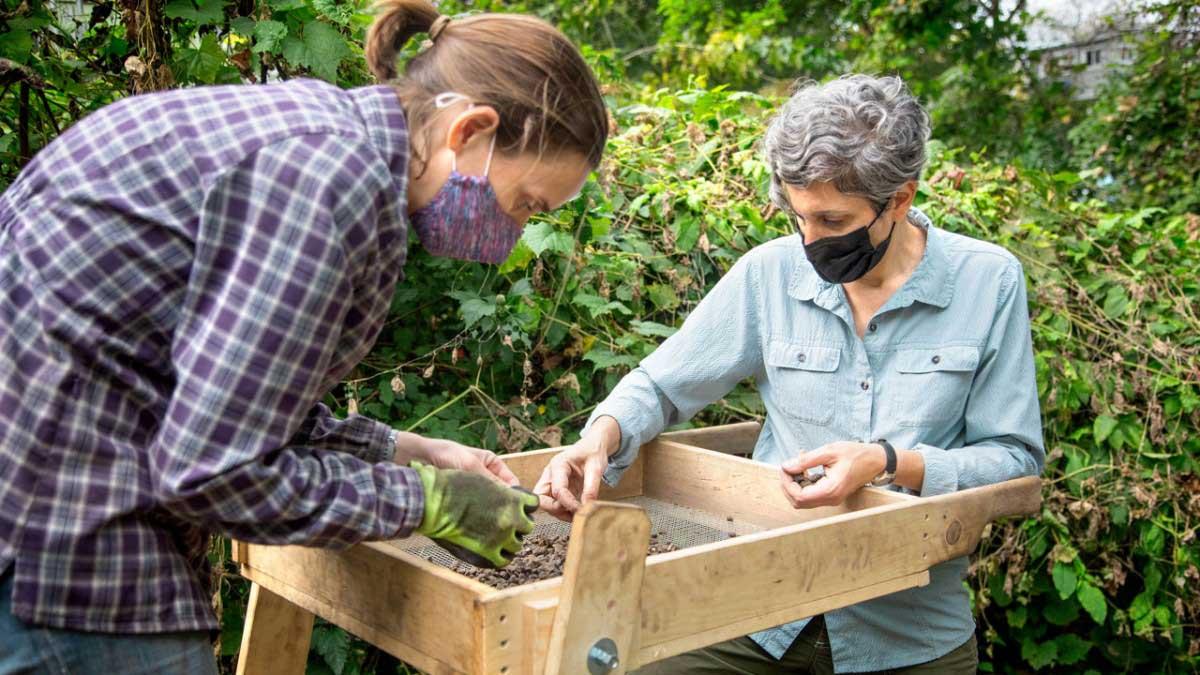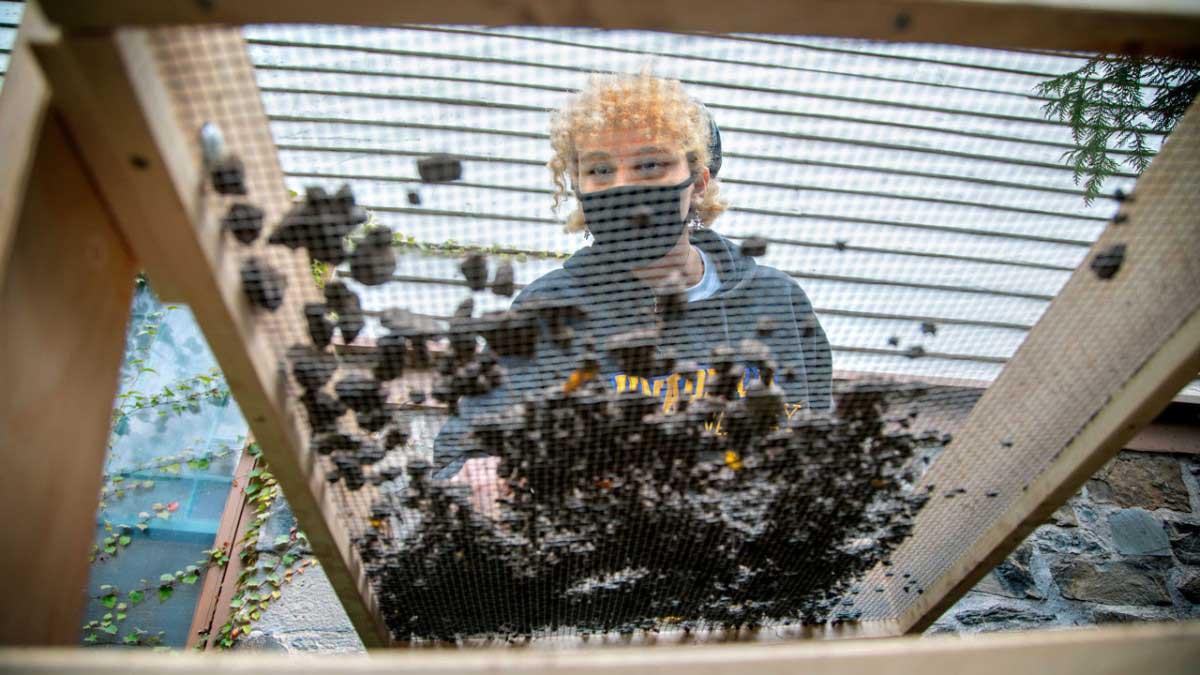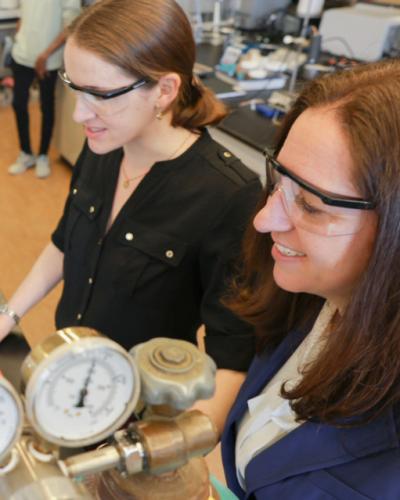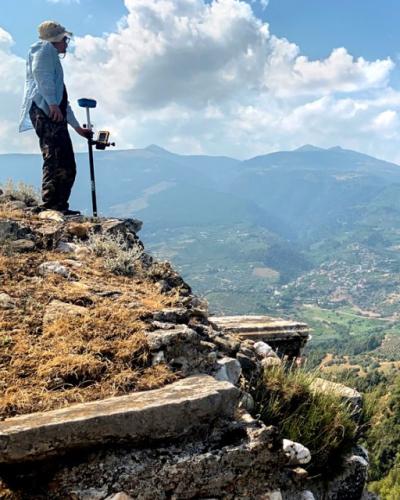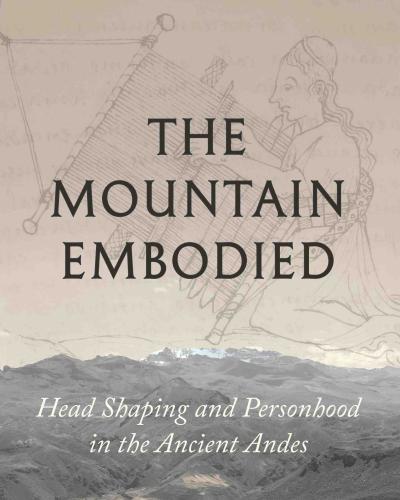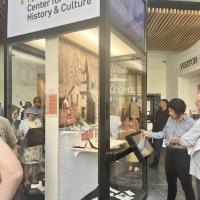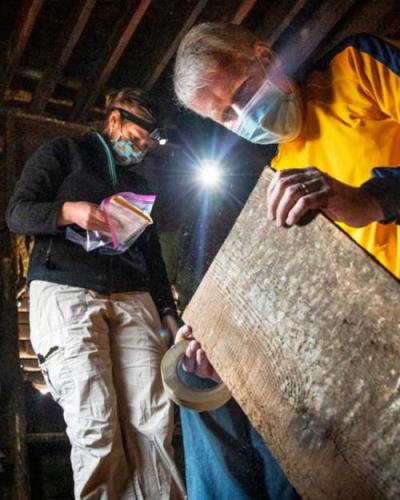Khalil Hicks, age 11, straddles a 3-foot square trench and points his trowel at the spot where he and his fellow archaeologists discovered an unexpected treasure – right near the stone foundation of St. James A.M.E. Zion Church, Ithaca’s most important Underground Railroad station.
Hicks was on sifting duty that day. At first he thought the compacted dirt in his sifting tray held nothing more than a rock. “Then I see a nail coming out,” he says. “I lifted it up in the sunlight and boom – a door hinge! Everybody was cheering on, because I had found something really big.”
It was the latest find at an excavation site where community members and a multidisciplinary team of Cornell faculty and students have been collaborating to learn more about St. James.
“The church is a treasure trove of history and we haven’t even scratched the surface,” says Rev. Terrance King, pastor of St. James.
It is believed to be the oldest religious structure in Ithaca. It is the world’s oldest active A.M.E. Zion church, a denomination known as “the freedom church” because of its role in the abolition movement. St. James hosted abolitionists including Frederick Douglass, who spoke there in 1852, and possibly Harriet Tubman, who visited Ithaca several times, had family members in the area and was a member of the denomination.
But much of the church’s history remains unknown – like whether there’s any truth to the rumor it sheltered enslaved freedom-seekers in a secret hiding place or tunnel.
Teams of local middle- and high school students, alongside Cornell faculty and students, spent Saturdays from Sept. 18 to Nov. 13 digging in five trenches on a small lawn next to the church where the original parsonage once stood. Neighbors frequently stopped by to check on their progress and even do some digging themselves.
“You can only do this as a team,” says Adam T. Smith, Distinguished Professor of Arts and Sciences in Anthropology in the College of Arts and Sciences (A&S), who is co-leading the excavation with Lori Khatchadourian, associate professor of Near Eastern studies (A&S). “It’s not just that we’re revealing the history of this community. We’re actually building community.”
Writing the building’s biography
In the church’s first floor fellowship hall, Khatchadourian leans over white cases holding a few of the artifacts they’ve found so far: fragments of glass bottles, a pressed glass punch-cup dating from the 1840s-60s, a fragment from the heel of a wooden shoe, shards of an LP record, fragments from fancy ceramic tableware and everyday unglazed pots, iron nails, wire nails, animal bones, bottle caps, bricks, coal. “Even small shards of pottery can be informative, particularly about everyday food ways and also economic questions – what people had access to and were able to afford,” she says.
For example, in the 19th and early 20th centuries, households were often heated with either cheap bituminous coal or more expensive anthracite. “It’s a bit surprising that we’re finding almost roughly equivalent amounts of bituminous and anthracite,” Khatchadourian says.
Every week she met with Fred Gleach, senior lecturer and curator of anthropology collections (A&S), and Sherene Baugher, professor of landscape architecture in the College of Agriculture and Life Sciences and a historical archaeologist specializing in North America, to “read” the artifacts. The items so far date mainly to the late 1800s and 1900s; on the last day of the dig, they uncovered the most exciting find: a penny dating to 1891.
The fact that they’ve already uncovered so many artifacts is encouraging. “That’s not always the case with archaeology,” she says. “Sometimes you dig and you find nothing. The artifacts we’re uncovering speak to the continuous history of the church, from the 19th century to the present.”
Discussions are ongoing about continuing the excavation in summer 2022; so many local students signed up for this year’s excavation that there is already a waiting list for next year.
The project is one of several initiatives of Cornell’s Underground Railroad Research Project, directed by Gerard Aching, professor of Africana and Romance Studies (A&S), and supported in part by a Fowkes Family New Frontier Grant from A&S.
Preliminary work began in summer 2020. Larry Brown, the Sidney Kaufman Professor in Geophysics in the College of Engineering, did ground penetrating radar scans and found clear anomalies in the church yard.
Eight faculty members affiliated with the Cornell Institute of Archaeology and Material Studies (CIAMS) are lending their expertise. Nerissa Russell, professor of anthropology, and Maia Dedrick, Hirsch Postdoctoral Associate in CIAMS, specialize in zooarchaeology and paleoethnobotany. Other faculty are sharing their knowledge of geophysics, dendrochronology, spatial analysis and North American archaeology. “We’re bringing everything to bear that Cornell archaeology has to offer,” Khatchadourian says.
On the church’s top floor, Sturt Manning, Distinguished Professor of Arts and Sciences in Classical Archaeology (A&S), and his undergrad and graduate students climb up a ladder into the church tower to collect wood samples. They’ve also explored the basement, where some timbers have been damaged by fire. “Over 150 years, this little corner seems to be one of the oldest areas, which has not really been touched,” Manning says.
With any luck, the samples will indicate the species of trees, whether they were grown locally or imported, and the year they were harvested. The timbers bolstering the burnt wood could provide the year the fire occurred, he said. “That’s the biography of the building that we hope to figure out,” he says.
Experiential learning
Back at the dig, Khalil Hicks describes the technique he’s learned from the Cornell archaeologists. “You’ve got to scrape the top layer – you don’t dig – and then you put all the scraped layers away into a pile. You scoop it all up, then you put it in a sifter,” he says.
Khalil collects gemstones and hopes to study archaeology or geology in college. “Rocks are my thing,” he says.
The excavation has provided the homeschooler with an invaluable opportunity to explore his passion, says John Hicks, Khalil’s father. “The biggest change I’ve seen is his level of patience in accomplishing a goal – setting a goal and being patient enough to deal with it.”
The excavation has also expanded the students’ grasp of mathematics, archaeology and technologies such as ground penetrating radar and drones used for mapping, say Ithaca teachers Denise Lee ’73 and Abe Lee ’73. They helped recruit participants through their Saturday Science and Mathematics Academy, a STEM-based nonprofit enrichment program aimed at students of color. Hicks is one of several academy members participating. “They have been just wowed with everything they’ve seen,” Denise Lee says. “You can’t say enough about this level of experiential learning,” Abe Lee adds. “You can’t aspire to what you haven’t been exposed to.”
Aching and King hope to create an Underground Railroad K-12 curriculum centered on St. James and a 3D digital model of the building. They plan to run a focus group of teachers in summer 2022, to understand what should go into an online “teachers’ toolbox” for educators around the country.
Academic research is also in the works. Aching is writing a monograph on a contemporary approach to the Underground Railroad, focused on his work with St. James. The archaeologists will write papers about their findings, the project as an unusual example of community archaeology, and the unique age range of students participating, from middle-schoolers through doctoral candidates. “This has never been mere philanthropic community service,” Aching says. “We’re all doing a lot of challenging and mutually beneficial learning here.”
King, a middle-school special education teacher, envisions an experiential curriculum in which students could do a scavenger hunt right in the church, and ring the bell in the belfry, as they learn about abolitionists like Douglass and Tubman. History will leap off textbook pages, he says.
“You don’t have to go to Rochester or Buffalo or Auburn to learn about these big names,” he says. “You can come right down to Cleveland Avenue and be in the middle of it.”
Taking great risks
On the church’s second floor, stained glass windows bathe the sanctuary in pastel sunlight. Church historian Nick Sledziona thumbs through a white binder that holds this history of St. James in clear plastic sleeves.
He reads from a letter to the editor published in the Ithaca Journal in 1889, in which a tanner describes an unnamed St. James pastor as a “very efficient” conductor on the Underground Railroad. “‘Every few days, he would come to my office and say that he had one, two, or three or four. He would ask me if I would give something to help them towards the North Star,’” Sledziona reads, noting “it’s an eyewitness account of a pastor who was active here at St. James, helping people escape to freedom.”
At least two St. James pastors were open about their abolitionist activities, Sledziona says. The most notable, Jermaine Loguen, was born a slave in Tennessee, escaped to freedom and spent much of his time in Syracuse, where his house was a major stop on the Underground Railroad. He wrote for the North Star, an abolitionist newspaper published by Douglass, who was a member of the A.M.E. Zion denomination.
These pastors were taking enormous risks, Aching says. After 1850, the Fugitive Slave Act made assisting a freedom-seeker a punishable offense. “You would be endangering other people’s livelihoods. You could have been thrown in jail for six months, which would ruin a family. Or you would be fined $1,000 – about $25,000 today,” Aching says. “That is remarkable. It was a federal effort to make certain that slave holders had the opportunity to regain who they considered to be their property.”
Tendrils of this history continue to twine around St. James, in the oral histories about a possible hiding place or tunnel.
So far, the Cornell team has seen no evidence of a hidden space. That’s not surprising, they say, because the church would have been the most obvious place for authorities to look for freedom-seekers.
“The fact that the church and the surrounding community are very close to Cayuga Lake – that is almost as interesting as anything,” Manning says. “What you’d be looking for are clandestine ways to travel. St. James is strategically very close to exactly where you’d get on a boat if you were going to head north.”
Discovering artifacts manufactured only in the South – a button, for example – is more likely. “We’re looking for any signs of materials that would have looked out of place in Ithaca in the 1840s,” Smith says. “These are people who would have been moving secretly and rapidly, but nevertheless they would have had stuff with them indicative of where they came from.”
Even so, the idea of a tunnel continues to capture people’s imaginations, Aching says, perhaps as a symbolic manifestation of the courage and hope it took for someone to flee a life of enslavement.
“You didn’t know where you would end up. You didn’t know how you would earn your livelihood,” he says. “But you were going to take the chance.”



